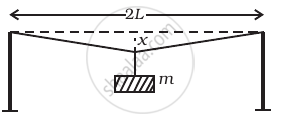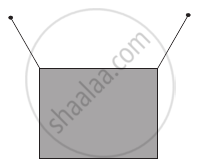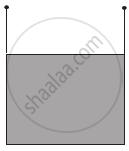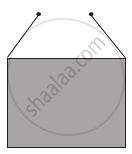Advertisements
Advertisements
प्रश्न
A rigid bar of mass 15 kg is supported symmetrically by three wires each 2.0 m long. Those at each end are of copper and the middle one is of iron. Determine the ratio of their diameters if each is to have the same tension.
उत्तर १
The tension force acting on each wire is the same. Thus, the extension in each case is the same. Since the wires are of the same length, the strain will also be the same.
The relation for Young’s modulus is given as:
`Y = "Stress"/"Strain" = (F/A)/"Strain" = ((4F)/(pid^2))/"Strain"` .....(i)
Where,
F = Tension force
A = Area of cross-section
d = Diameter of the wire
It can be inferred from equation (i) that `Y prop 1/d^2`
Young’s modulus for iron, Y1 = 190 × 109 Pa
Diameter of the iron wire = d1
Young’s modulus for copper, Y2 = 120 × 109 Pa
Diameter of the copper wire = d2
Therefore, the ratio of their diameters is given as:
`d_2/d_1 = sqrt(Y_1/Y_2) = sqrt((190xx10^9)/(120xx10^9)) = sqrt(19/12) = 1:25:1`
उत्तर २
Since each wire is to have same tension, therefore, each wire has the same extension. Moreover, each wire has the same initial length.So, the strain is same for each wire.
Now, `Y = "Stress"/"Strain" = (F/((piD^2)/4))/"Strain"`
or `Y prop 1/D^2 => D prop 1/sqrtY`
`D_"copper"/(D_"iron") = sqrt((Y_""iron)/(Y_"copper")) = sqrt((190 xx 10^9)/(110 xx 10^9)) = sqrt(19/11) =1.314`
APPEARS IN
संबंधित प्रश्न
When a block a mass M is suspended by a long wire of length L, the elastic potential potential energy stored in the wire is `1/2` × stress × strain × volume. Show that it is equal to `1/2` Mgl, where l is the extension. The loss in gravitational potential energy of the mass earth system is Mgl. Where does the remaining `1/2` Mgl energy go ?
When the skeleton of an elephant and the skeleton of a mouse are prepared in the same size, the bones of the elephant are shown thicker than those of the mouse. Explain why the bones of an elephant are thicker than proportionate. The bones are expected to withstand the stress due to the weight of the animal.
The yield point of a typical solid is about 1%. Suppose you are lying horizontally and two persons are pulling your hands and two persons are pulling your legs along your own length. How much will be the increase in your length if the strain is 1% ? Do you think your yield point is 1% or much less than that?
The breaking stress of a wire depends on
A charged particle is moving in a uniform magnetic field in a circular path of radius R. When the energy of the particle becomes three times the original, the new radius will be ______.
A spiral spring is stretched by a weight. The strain will be:
A mild steel wire of length 2L and cross-sectional area A is stretched, well within elastic limit, horizontally between two pillars (Figure). A mass m is suspended from the mid point of the wire. Strain in the wire is ______.

A rectangular frame is to be suspended symmetrically by two strings of equal length on two supports (Figure). It can be done in one of the following three ways;
| (a) |  |
| (b) |  |
| (c) |  |
The tension in the strings will be ______.
If 'S' is stress and 'Y' is young's modulus of the material of a wire, the energy stored in the wire per unit volume is ______.
The area of the cross-section of the rope used to lift a load by a crane is 2.5 × 10-4m2. The maximum lifting capacity of the crane is 10 metric tons. To increase the lifting capacity of the crane to 25 metric tons, the required area of cross-section of the rope should be ______.
(take g = 10 ms-2)
